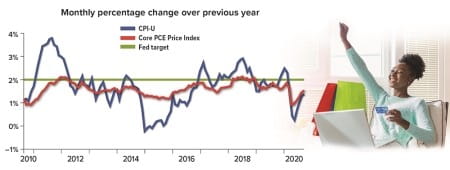Different Inflation Measures, Different Purposes
The inflation measure most often mentioned in the media is the Consumer Price Index for All Urban Consumers (CPI-U), which tracks the average change in prices paid by consumers over time for a fixed basket of goods and services. In setting economic policy, however, the Federal Reserve Open Market Committee focuses on a different measure of inflation — the Personal Consumption Expenditures (PCE) Price Index, which is based on a broader range of expenditures and reflects changes in consumer choices. More specifically, the Fed focuses on "core PCE," which strips out volatile food and energy categories that are less likely to respond to monetary policy. Over the last 10 years, core PCE prices have generally run below the Fed's 2% inflation target.

Sources: U.S. Bureau of Labor Statistics and U.S. Bureau of Economic Analysis, 2020 (data for the period September 2010 to September 2020)
Content provided by Forefield for use by Eliot M. Weissberg, CFP®, CFS, of Raymond James Financial Services, Inc., Member FINRA/SIPC. The Investors Center, Inc. is an independent company. The information contained in this report does not purport to be a complete description of the securities, markets, or developments referred to in this material. The information has been obtained from various sources considered to be reliable, but we do not guarantee that the foregoing material is accurate or complete. Any opinions are those of Eliot Weissberg and not necessarily those of RJFS or Raymond James. Expressions of opinion are as of this date and are subject to change without notice.
This information is not intended as a solicitation or an offer to buy or sell any security referred to herein. Past performances may not be indicative of future results. You should discuss any tax or legal matters with the appropriate professional.


